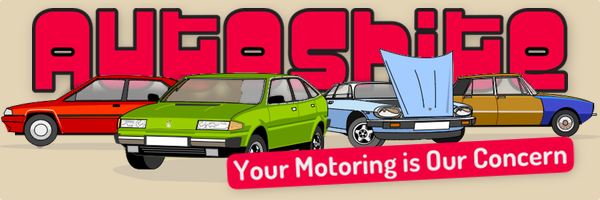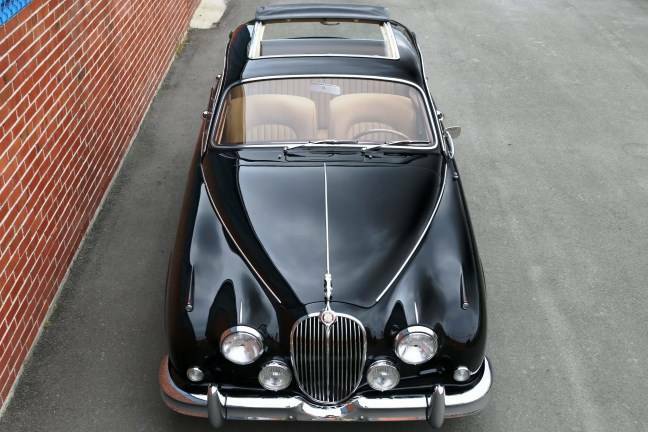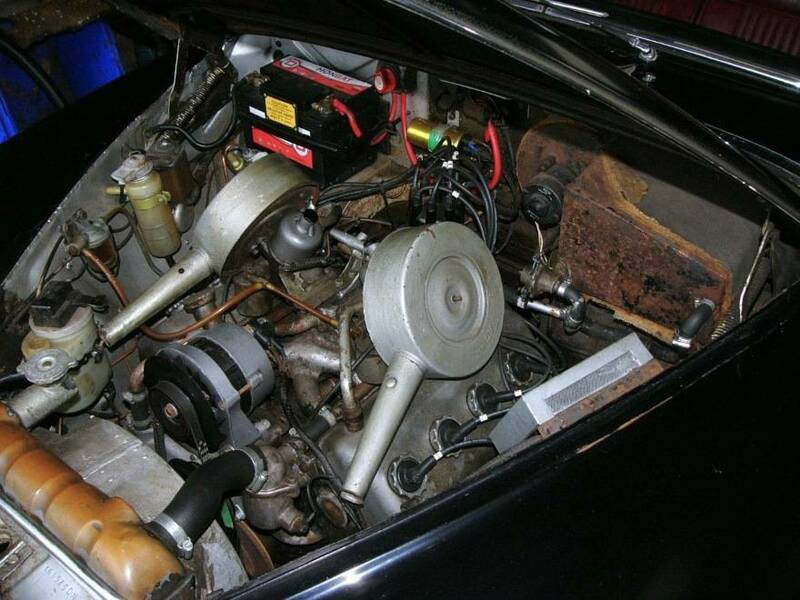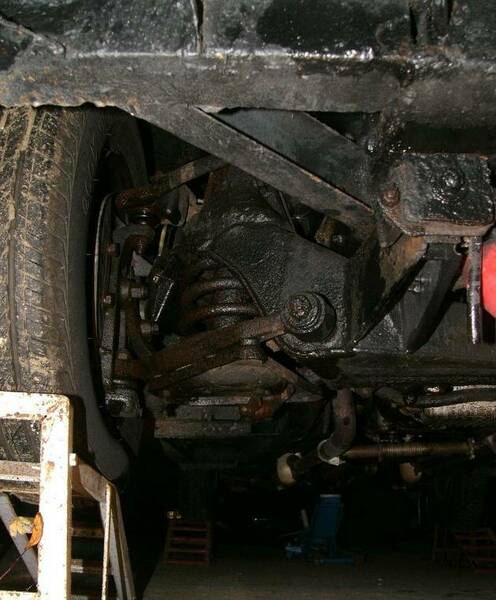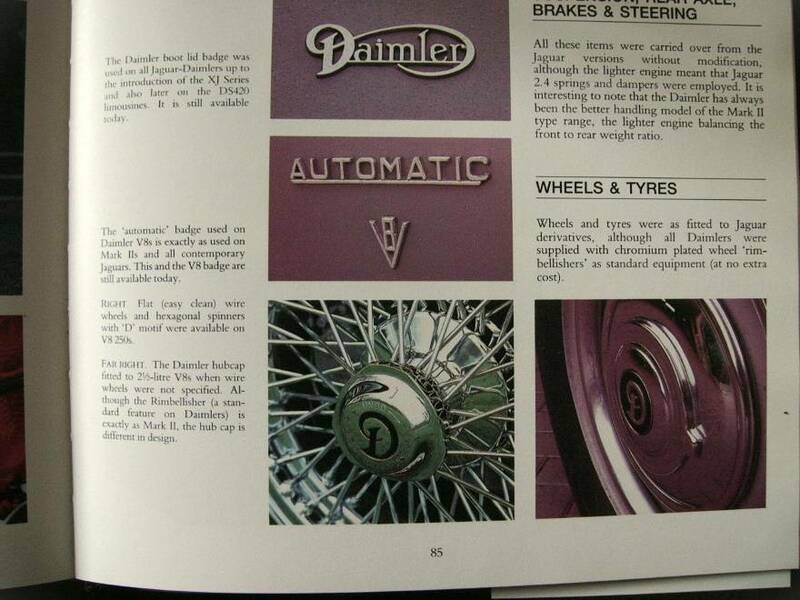-
Posts
3,033 -
Joined
-
Last visited
Content Type
Profiles
Forums
Events
Everything posted by Bfg
-
Tudor_Websasto_sunroof_manual_part 1, page 2 " Pass the cold chisel Fred ..and a big 'ammer ..got to make an 'ole in this nice Daimler's roof " 🤓
-
For your delight and delectation I give you . . . 1958 Motor show feature from 1923 1936 and 1944 . From 1954 and 1966 ..so do you reckon they've got much experience in making weather resistant roofs ?
-
Yes I remember those. Good spot !
-
Sure, why not ? I'm sure it'll all be fine by the time the big 'voiced' lady sings.! true, I may not get it as perfect as a seasoned professional might, but I've certainly done very much more risky things than this. Have faith my friend.
-
-
And now for something completely different .. if you'd forgive a slightly lateral step on the theme of this topic ..for although I knew of the vehicle - I neither knew the name of the man behind it, nor did I realise just how long ago such a motorised vehicle able to carry four persons ..and draw 4 tons along the road, was designed, built and tested. Nicolas Joseph Cugnot (engineer) - (French. b. 26 February 1725. d. 2 October 1804) invented and built this steam powered Fardier à vapeur (..a fardier was a massively built two-wheeled horse-drawn cart for transporting very heavy equipment, so in essence a 'steam-powered flat-bed' haulage tractor) 254 years ago ..yes Two-hundred and fifty-four Years ago.! The tractor unit was articulated to the trailer (surely an idea that would never catch on !? ), and it was built to a military specification ; to be able to carry or draw along four tons and cover two lieue (7.8 km, or 4.8 miles) in one hour. It never achieved that specification but it did drive under its own power. In 1770, a full sized Fardier was built and it travelled at a speed of 4 km/h (little over 2mph) with a running time of fifteen minutes, before its relatively small boiler need to be refired and the steam raised again. This was a decade and half before higher pressure steam engines were fervently opposed by certain persons British history better remembers.. Messrs James Watt and Matthew Boulton < more here > and < here > with < video here >. And for those interested in the history of steam road vehicles < here's > another Wikipedia link. And here was I thinking 'motor vehicles that ran on the open road ground (ie., not along rails / tracks) before WW.1 were really old'. Pete
-
..when I was living / working in the States, back in the mid 90's, I bought a XK150s Roadster (project) which had been butcher converted (..hacked firewall with numerous rivetted-on plates to reshape it) to accept a small block Chevrolet lump with automatic transmission. I then spent $$-thousands on buying the correct engine block, the correct cylinder head and the correct inlet manifolds (with its triple carb setup being similar to the Mk10 but unique to the 150S spec), the gearbox and diff (..I had to buy three of each of these from the seller just to get the one I needed).. only to then be made redundant and have to leave the country within 30 days.! I sold that car and all the parts for $6,000 in 1999, when the exchange rate was closer to $2 = £1 ..because I couldn't afford to pay for storage nor to ship it back to the UK. The XK150 car is my all time favourite, which because of their current values led me to start looking for a Mk9 Jaguar. The prices for these big saloons is still not so unreasonable (..for driveable project cars) but I was stumped by their size. Way too big to park in 99% of town garages, so I'd need to rent barn space. Considering that impractical I bought the next nearest ..a so called 'compact saloon', albeit of the presently cheaper Daimler brand. But at least I found a survivor with manual + overdrive. I blame it all on my Dad who when I was a boy bought a Mk7 Jaguar I remember my brothers and I cleaning the car when it rained (Dad was RAF and at that time we lived in Singapore) with me standing on the armrests of the front seats to reach out of the (factory fitted steel) sun-roof to clean other parts of the roof with a sponge. Yes even this Bfg was once a little boy.!
-
Mally, i do hope you recognise the raspberry blowing Alan Alda gif from the MASH series, in my reply, is targetted at the commercial world we live in ..and not at you personally. I really apologise if you felt I was being rude to you. That was not at all my intent. Having struggled to afford nice things for almost all of my life, and equally seeing so many others, who work long hours, hard and conscientiously., struggling while rich people walk over them to get fatter and ever more arrogant (as I see it ! ) - I've developed quite an odd distaste for monetary value in everything &/or being motivated by value and profit. I'd just like what I buy to be enjoyable for me in the few remaining active years I have left (..without my actions or thoughts being hurtful to anybody else), rather than my feeling compelled to pamper for whatever a next owner (richer-guy who doesn't get his hands dirty) may want. I am sorry if my post came across as offensive. Pete
-
I cannot disagree with that 😎 very nice and looking like fun .
-
I have no kids, nor wife, and I'm in my late 60's , so ... ..just kidding 😃
-
Not to my taste ..but then what I do with my cars is not to other's idea of good taste. By coincidence I'm presently trying to choose a new colour for my own car. It's the first time I've ever afforded to have a full respray (a friend's prices) and will all the beautiful colours under the rainbow - the choice isn't easy. Most likely I won't be choosing a greenish mint interior though. My Daimler was opalescent silver (light grey) from the factory with red leather, and as you can now see she's filthy-cat-from-the-coal-bunker black, which I know from prior experience is a sod to keep clean. Tbh., I'd love a really dark-opalescent-blue, or perhaps an almost black-green which to my eyes suits the conservative persona of a Daimler, but then those shades of colour would be equally as difficult to keep clean. I also happen to like a lighter colour inside the engine bay and under the car. I was very tempted by the opalescent maroon but right now I'm looking more and more at the metallic / opalescent colours of the later XJ6 Jaguar range. They did a lovely sage green both as a light tone and a darker one, a choice of light or mid range blues with a tinge of gun-metal, and even their sandy gold was tastefully rich and warm. I'm still undecided, but the red seats in my car will most likely remain. And then I see a photo of a silver Daimler with red seats and that reminds me of the Jabekke record breaking TR2 ..and that opalescent ice-mint colour looks good too. Of course any colour I look at is subject to the photographer, the weather / ambient light and reflections, and to this computer screen. Hey ho the decision is not made yet. I'm sure I'll be happy with whichever ! I will of course be working to a budget quite unlike Beecham's. I also see no point in adding a more powerful modern engine to a car that must still have the finer traits of 1960's narrow wheelbase handling and steering. I also feel the old XK Jag engine was a delight to open the bonnet for, whereas matt black engine shrouds simply don't float my boat. It makes me wonder if there's an electric motor under the vacuum-formed cover ? ..sorta like a Scalextric Jagwaar-Dameler. Nor does a fat steeling wheel or a centre console of dozens of black buttons that you can't find by feel when driving at night. It looks to me as if they've placed a mk2 body shell on a different Jag, and lost all but the body lines of the experience of owning a classic. Wire wheels were a sporty extra (in stark contrast to the fat air-bag steering wheel) and to me are out of context on a Daimler, and I'd still prefer an open sunroof (webasto type) to air-con. But aside from that .... 🤪 Now where was I ? oh yes, decisions, decisions, what colour ? ..I'm veering towards a lighter opalescent almost Wedgwood blue. . .
-
hey I live in Anglia ! .. it's not all shonky. 🌝
-
looks as if the concept car is getting in the flippin way
-
Bought as a rag top, my other car is a TR4 with a Surrey top, I wouldn't dream of making that into a closed saloon car. And in my present home I miss having the patio window.. ^ If I had the money I'd have one of these, or this ^^ ...and employ a window cleaner ! or on the cheap ..one of these ^ Imho., the premature end to millions of cars, was not due to any form of sunroof ..that was never fitted, but rust creeping up from the underside and dissolving the sills, structural mountings, the bottom of the doors, wings and wheel arches. I certainly acknowledge the fact that many sunroofs leaked, particularly those retrofitted where a hole was cut through a thin roof panel and no return flange was welded in, so when a fabric sunroof was fitted the edges of the roof panel flexed. I'd also suggest that cars of the 60's are now rarely used as daily drivers left out in all weathers, so destructive leaks should not be the same extent of problem that they once were. Pete
-
Lots of minor jobs to do around the car, starting with rubber suspension parts under the car, and I wish to have her repainted, but I'd also really love to fit a sliding fabric sunroof, like the attached photos. Has anyone got a used / repairable Webasto, possibly about 35" wide x 45" long ..typically Rover sized.. that I might buy ? And has anyone personal experience of fitted one ..to a car with such a rounded roof ? I'd be glad to hear from you with advice. Jaguar used to offer these from new, as a special order option, and the inside of the roof was reinforced at its cut edges by the factory. I have a copy of Webasto's fitting instructions, but not of Jaguar's reinforcement. Perhaps someone can help. Cheers, Pete .. please excuse the wire wheels and white wall tyres ..which look very American
-
I cannot really agree with this as the small V8 hemi when used in the Sp250 was neither boring nor conventional. Nor I feel were any of the Daimler models after Jaguar's takeover in 1960. There was undoubtable a flat spot in car styling between the war and the 1960's, but focus was on moving towards uni-body and monocoque structures, which at the time implied heavy cars of blob shapes from almost every saloon car manufacturer.
-
Time to get my hands dirty . . . Up on ramps and with the bonnet open for squirting penetrating-lubrication fluid over every nut n' bolt and every linkage, as well as the back face of the bumpers and under the wings, etc. I did the same with the door, bonnet and boot hinges and their locks, as well as the control cables / linkages for throttle, choke, heater, scuttle vent, etc. etc. Having read a few on-line reviews the PlusGas, Holts Rustola and WD-40 seem to attract most favourable comment. In my own little test I haven't yet assessed which fastening comes loose easiest but I have observed ; PlusGas was the most expensive but then seemed to offer consistent & good pressure to the very end of the can, as well as having a particularly accurate squirt (using the pin-pointer tube) into places that weren't accessible (for example when aimed at linkages or fastenings 18" away down behind the engine). The Holts Rustola I haven't tried yet because it doesn't accept a tube for pinpointing where I want to lubricate. Without it, the spray came out a bit too fanned out. The WD-40 was the cheapest to buy (from Euro Car Parts it was just £6 for a 600ml can). I found its squirt seemed a little too much and so it splashed more and wasted more. Then as the can reach half empty/full the spray became inconsistent. Later on it would only spray when the can was upright, which is inconvenient when laying/working under the car. Annoyingly, the pin-pointer tube kept on coming out of the spray head and the outside of the can became slippery with lubricant. The SAS (with PTFE) ..when using the long pin-point tube off the PlusGas, sprayed as fine mist. This seemed economical and was useful in certain places where I wanted to inject a broad mist of lubricant, for example on top of the front suspension's bottom spring pan. The GT85 (with PTFE) is physically the smallest sized can, despite claiming the same 400ml capacity as the PlusGas. Its pressure is less and its small size is perhaps easier to handle with or without the pinpointing tube. I'm sure you all have your own preference so I'll not draw a conclusion, save that getting the penetrating fluid / lubricant where you want it, in the small quantity you want, together with consistency of spray when you're in awkward positions - relates to value and ease of use. Maybe, at times, these attributes are as important as the product's ability to do its penetrating/lubricating task. Accordingly I think I'll veer towards PlusGas and SAS for future purchases. ^ not bad nick for a car first registered in January 1968, but there's plenty of scope for tarting up, maintenance and improvement. Nice to find clean air filters in the canisters, and newish looking jubilee clips on the still supple rubber hoses. The clutch has been replaced recently, and the brakes are very well sorted, tyres are likewise very good (save the spare), and there are still the manufacturer's paper labels on the stainless steel exhaust. Someone's spent some sensible money on maintenance of this car ^ rear wheel arch spats are each in amazingly good condition, but mice appeared to have taken up home in the rear seat's foam. I don't know if they are still in there ..but if they are - they won't be feasting for very much longer.! The weather was bright when I first arrived at the storage unit, and then it rained consistently ..until I'd packed up to come home. Hey ho it could have been very much worse. Pete
-
End of Season opportunity to enjoy clearer roads as yesterday I went back across to the Norfolk and Suffolk Aviation Museum, Flixton, Suffolk, NR35 1NZ(which at this time of year is opened only on Sundays). From where I live it's some 35 across country miles away but, since moving home a few months ago, the route is different. I love this museum because it’s a local one and that makes it unpretentious. It might be noted that it’s a volunteer-run museum charity, and lacking the glamorous and glossy exhibits of well funded museums, but perhaps because of that - it is fascinating. In many ways it’s more like an old workshop packed with minute details. East Anglia was of course dotted with airfields throughout the 2nd WW, and the memorabilia and photographs reflects the true grit of it. More depth is found in the stories relayed by airmen, farm workers (who witnessed aircraft crashes of both friend n' foe) and of the air-sea rescued. These do take a time to read, but there’s humanity in there which isn’t reflected in the glossy paint of a restored museum exhibit, however awesome an aircraft style &/or its specs may be. My visiting on Sunday 12th, the day of the National Service of Remembrance, was poignant. ^ far right, yes behind the curtain in the anson is the ..... With so many artefacts found in gardens, along the coastline & esturies, and farmland across East Anglian counties - it may to the uninitiated seem to be filled with mangled pieces of metal, cloth or whatever, but to an engineering mind - those same objects are like cutaway illustrations ..or rather sculptures, revealing in life-scale the guts and the craftsmanship in engineering. Pete
-
There's never a black cab around when you want one !
-
" The Utah facelift was announced as the Mk2 Jaguar on 2 October 1959" is under a photo, similiarly captioned "Utah facelift", of a Daimler 2-1/2 (..with fluted grille) ..which Jaguar Cars didn't buy until mid-1960. These cars, the Daimler derivative of their Mk.II, wasn't available before October 1962.
-
I'm no expert but Nigel Thorley says the pressed steel wheels with hubcaps and chromed rim embellishers were standard on the Daimler 2-1/2 and Daimler 250 (although their hub caps were of a different style on the later cars) but that chromed wire wheels were an option on the later (slim bumper) model.. Daimler 250. You'll note from the photos the scrolled-D logo on three-sided spinners. The Jaguars had its name across their spinners ..which were two eared for the UK market. ^ The chrome wire wheels on Tony's 87,000 mile Daimler 250 are probably original from the factory or Dealer. I din't know the wire wheels weren't an option on the earlier Daimler 2-1/2 (fat bumper) model, as implied by Nigel Thorley. Certainly a 1964 car of that model I'd previously owned had chromed wire wheels. I hadn't realised they had been retro fitted. Every day is a school day ! Pete
-
I certainly don't mind the steel wheels on the Daimler, so have no plans to change them. I'm happy for those who have Jagwaars to keep their spokes.
-
Here is something you don't see very often .. Two Daimler 250's, 1968 and 1969 respectively, each in black with red leather, each with less than 90k miles on the clock (genuine), and each with manual / overdrive. Tony's owned his for some 20 years now, and I've own mine for some 20 days now. His is in very beautiful and original condition complete with chrome wires and PAS ...but I'm still delighted with mine (..the one with the lesser shine). I've just met Tony through a Facebook Daimler group, and so this was our first rendezvous to talk about these cars over a cuppa. He very kindly agreed to take me out in his (I asked, as he seems very modest) ..so I might know what to expect in terms of ride, comfort, driver response, noise levels, oil pressures, etc., etc. The steering wheel is an aftermarket one, but it's a nice compliment to the Daimler's original wooden dash and A-post trim. Pete p.s. on the way home I stopped to take this village green photo of my car . . .
